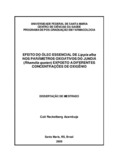| dc.creator | Azambuja, Cati Reckelberg | |
| dc.date.accessioned | 2015-02-23 | |
| dc.date.available | 2015-02-23 | |
| dc.date.issued | 2009-09-01 | |
| dc.identifier.citation | AZAMBUJA, Cati Reckelberg. Effect of the essential oil of lippia alba on oxidative parameters of silver catfish (Rhamdia quelen) exposed a differents oxygen levels. 2009. 54 f. Dissertação (Mestrado em Farmácia) - Universidade Federal de Santa Maria, Santa Maria, 2009. | por |
| dc.identifier.uri | http://repositorio.ufsm.br/handle/1/9002 | |
| dc.description.abstract | Juvenile silver fish (Rhamdia quelen) were exposed to the essential oil of
Lippia alba (L. alba) and transported in plastic bags for different periods (5, 6 and 7
h) yielding final different oxygen levels. The biomarkers of oxidative stress,
lipoperoxidation (LPO), catalase (CAT), superoxide dismutase (SOD), and
glutathione-S-transferase (GST) were measured in the liver, gills and brain of the
fish. The juveniles were assigned to 6 different treatment groups according to the
presence or not of the essential oil of L. alba in water (10 μL/L) and the length of
transportation, which determined the final concentration of dissolved oxygen inside
the bags: Five hours: hyperoxia (13.25 ± 0.35 mg/L O2); hyperoxia with L. alba (11.27
± 0.22 mg/L O2); Six hours: normoxia (7.35 ± 0.35 mg/L O2); normoxia with L. alba
(7.29 ± 0.40 mg/L O2); Seven hours: hypoxia (2.29 ± 0.36 mg/L O2); hypoxia with L.
alba (3.82 ± 0.7 mg/L O2). The addition of essential oil of L. alba causes an increase
of LPO in the tissues exposed to hyperoxia and a reduction of GST in the fish kept
under hyperoxia and hypoxia as compared to those under normoxia. In the tissues
there is a reduction of LPO and GST and an increase of SOD in the specimens under
hypoxia and a reduction of GST in those under hyperoxia with the oil. These results
suggest that the presence of the essential oil of L. alba improves the redox state in
the evaluated tissues, both under hyperoxia and under hypoxia. | eng |
| dc.format | application/pdf | por |
| dc.language | por | por |
| dc.publisher | Universidade Federal de Santa Maria | por |
| dc.rights | Acesso Aberto | por |
| dc.subject | Estresse oxidativo | por |
| dc.subject | Enzimas antioxidantes | por |
| dc.subject | Peroxidação lipídica | por |
| dc.subject | Disponibilidade de oxigênio | por |
| dc.subject | Lippia alba | por |
| dc.subject | Peixe | por |
| dc.subject | Oxidative stress | eng |
| dc.subject | Antioxidant enzymes | eng |
| dc.subject | Lipid peroxidation | eng |
| dc.subject | Oxygen availability | eng |
| dc.subject | Lippia alba | eng |
| dc.subject | Fish | eng |
| dc.title | Efeito do óleo essencial de lippia alba nos parâmetros oxidativos do jundiá (Rhamdia quelen) exposto a diferentes concentrações de oxigênio | por |
| dc.title.alternative | Effect of the essential oil of lippia alba on oxidative parameters of silver catfish (Rhamdia quelen) exposed a differents oxygen levels | eng |
| dc.type | Dissertação | por |
| dc.description.resumo | Juvenis de jundiá (Rhamdia quelen) foram expostos ao óleo essencial de
Lippia alba (L. alba) e transportados em sacos plásticos por períodos diferentes (5, 6
e 7 h) produzindo diferentes concentrações finais de oxigênio. Os biomarcadores de
estresse oxidativo, lipoperoxidação (LPO), catalase (CAT), superóxido dismutase
(SOD), e glutationa-S-transferase (GST) foram mensurados em fígado, brânquias e
cérebro de peixes. Os juvenis foram separados em 6 grupos de tratamento
diferentes de acordo com a presença ou não do óleo essencial de L. alba na água
(10 μL/L) e o tempo de transporte, o qual determinou a concentração final de
oxigênio dissolvido no interior dos sacos: Cinco horas: hiperóxia (13.25 ± 0.35 mg/L
O2); hiperóxia com L. alba (11.27 ± 0.22 mg/L O2); Seis horas: normóxia (7.35 ± 0.35
mg/L O2); normóxia com L. alba (7.29 ± 0.40 mg/L O2); Sete horas: hipóxia (2.29 ±
0.36 mg/L O2); hipóxia com L. alba (3.82 ± 0.7 mg/L O2). A adição do óleo essencial
de L. alba causou um aumento da LPO nos tecidos expostos a hiperóxia e uma
redução da GST nos peixes mantidos sob hiperóxia e hipóxia comparado aqueles
sob normóxia. Nos tecidos houve uma redução da LPO e GST e um aumento da
SOD nas espécies sob hipóxia e uma redução da GST naqueles sob hiperóxia com
óleo. Estes resultados sugerem que a presença do óleo essencial de L. alba melhora
o estado redox nos tecidos avaliados, ambos sob hiperóxia e sob hipóxia. | por |
| dc.contributor.advisor1 | Llesuy, Susana Francisca | |
| dc.contributor.advisor1Lattes | http://lattes.cnpq.br/6034025299975746 | por |
| dc.contributor.referee1 | Wilhelm Filho, Danilo | |
| dc.contributor.referee1Lattes | http://lattes.cnpq.br/4565173010472935 | por |
| dc.contributor.referee2 | Araujo, Alex Sander da Rosa | |
| dc.contributor.referee2Lattes | http://lattes.cnpq.br/7994626656627010 | por |
| dc.contributor.referee3 | Zanchet, Eliane Maria | |
| dc.contributor.referee3Lattes | http://lattes.cnpq.br/7658264982315631 | por |
| dc.creator.Lattes | http://lattes.cnpq.br/4797871208442100 | por |
| dc.publisher.country | BR | por |
| dc.publisher.department | Farmacologia | por |
| dc.publisher.initials | UFSM | por |
| dc.publisher.program | Programa de Pós-Graduação em Farmacologia | por |
| dc.subject.cnpq | CNPQ::CIENCIAS BIOLOGICAS::FARMACOLOGIA | por |


